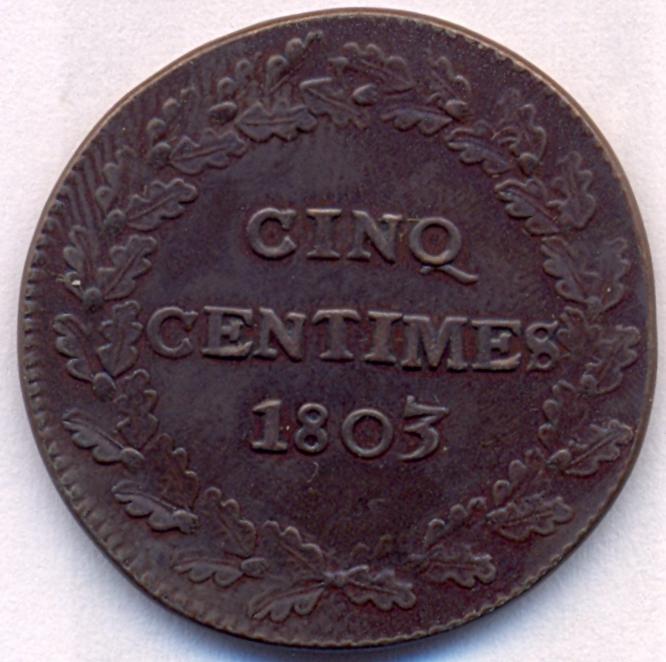 |
 |
| The French colonies in North America |
| The French Colonies in North America series contains four issues chronologically by date on coins: Arkansas Post (poste Aux Akansas) 1690 (issued in copper and silver), Massacre Island (Isle Du Massacre) 1699 (issued in copper and silver), Dauphin Island (Isle Dauphin) 1707 (issued in copper and silver) and New France (La Nouvelle France) 1803 (issued in copper only). | |
| Massacre Island (Isle Du Massacre) 1699: As we know from our history books, the French colonized the middle part of North America in the name of King Louis XIV, calling it Nouvelle France, or just Louisiana. One of the earliest French settlements was on the coast of the Gulf of Mexico. It was an island just four miles off the mainland near the mouth of Mobile bay in south Alabama, at a natural deepwater port that is today called Dauphin Island. In 1699, the French explorer, Pierre Le Moyne deIberville named it "Isle Du Massacre" (Massacre Island)because of a large pile of human skeletons he discovered there. It turned out to be a burial mound that had been broken open by a hurricane, not a massacre site, but the name stuck. deIberville decided to locate a colony here because of the abundant timber, reliable supply of fresh water, and a great deep-water harbor. "Massacre Island" soon became the headquarters for French colonization along the Gulf Coast. The thriving settlement consisted of a fort, a chapel, government owned warehouses, and many private homes. | |
| We issue this
comemmorative colonial piece to celebrate the history of the island in a
coin that could conceivably have existed. The obverse shows the haughty King
Louis XIV at his jowly best... you can almost hear him shout "Letat, cest
moi!" (translation: "I AM the state!") as advisers and sycophants bow and
scurry at his feet! The inscriptions declare him king of France and her
colonies. The reverse bears the royal crown above, and a shield of three
skulls to represent the colony, with the inscription "Isle Massacre" and the
date 1699. In our unabashedly fictionalized version of events, we suggest that the crown authorized the minting of this colonial coin, but that the engravers design with shield of skulls turned out to be too lurid for the refined folk who were being urged to relocate to the colony. The chest of coins was locked away in a back-room at the mint, where it would sit out the revolution, two world wars, and would finally be discovered during a renovation just last year. This largish copper coin denominated one-sol, weighs about 9 grammes of pure copper, is about 26 mm in diameter, and is done in the classic style of 17th century French coinage. The condition of the is EF+ (extremely fine plus) with little wear and a delicate toning. The silver version of the Isle Du Massacre coin, struck on the same dies... This largish silver coin denominated one quarter Ecu, weighs about 6 grammes of 90% silver, is about 26 mm in diameter, and is done in the classic style of 17th century French coinage. The condition of the is EF+ (extremely fine plus) with little wear and a delicate toning. This piece is brought to you by Shire Post, specializing in crafting strange and unusual artifacts from all over the world for the purpose of making history come alive. |
|
| New France (La Nouvelle France) 1803 : As we know from our history books, the military dictator and self styled "emperor" Napoleon Bonaparte of France, acquired titular rights to the western part of the watershed of the Mississippi river from Spain in 1801. His plan, according to historians, was to use the vast resources of this territory as a springboard to cross the Pacific and conquer Asia and the world. His plans were thwarted however, by a seemingly unlikely foe. A slave uprising on the island of Hispanola (more recently known as Haiti) diverted the troops Napoleon intended to occupy New Orleans, and by 1802 had sapped his strength. He was now faced with a difficult decision with regard to the North America he liked to call "New France". If his forces attempted to control New Orleans in their now-weakened condition, he feared the Americans under Thomas Jefferson would attack to restore their back-door on the river. This fear appears justified given Jefferson's memoirs. This would be a war that Napoleon knew he could not win... it would cost him much and he would lose his toehold in North America... dashing his plan of world conquest in the bargain. On the other hand... if he were to SELL the rights to the Americans... they would both avoid a war and he might obtain enough money to fund his battles to at least gain control of Europe. Thus began the negotiations for the sale that would unlimately be known as the Louisiana Purchase. | |
 |
 |
| A comemmorative coin that might have been isued for Nepoleon Bonaparte's colony of "La Nouvelle France" shortly before his decision to sell the land to the young United States. Struck in 9.00 gram of pure copper. | |
| In our creative interpretation of events, we surmise that Napoleon may have ordered coinage struck for his colony, and indeed, even after negotiations for the Louisiana Purchase had begun, he might have been promoting the idea to the Americans that he still intended to occupy. The introduction of coinage as currency for the New Orleans colony would certainly be seen as an indication of such intent! The result might be a significant rise in the monetary offer for the territory! So here we offer it... a copper 5-centimes piece of 1803, made and circulated to goad Thomas Jefferson into making a significantly higher offer in order to avoid an even more costly conflict. It could have happened!!! | |
| Micro-Nations | |
| Chiefa Coins | |